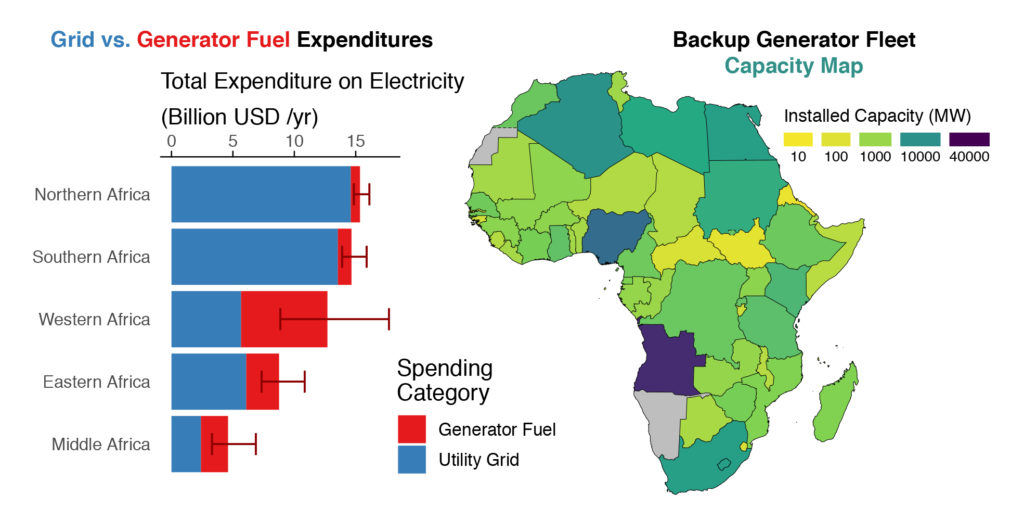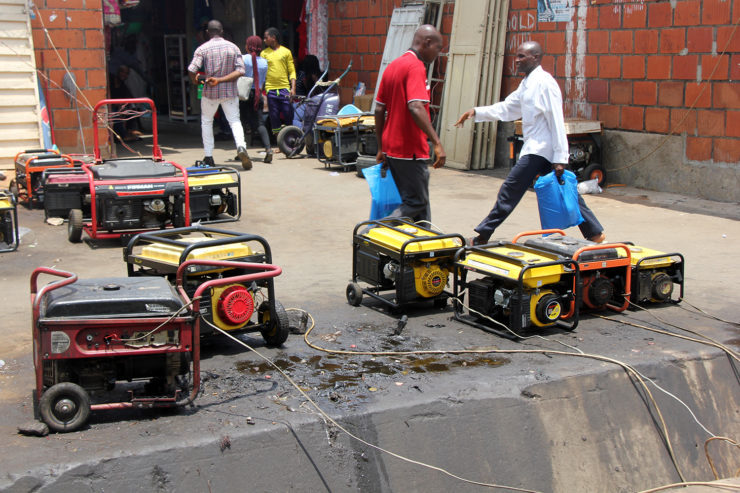Between 1-2 billion people live without reliable access to an electrical grid. Homes and businesses in these communities suffer outages that last from hundreds to thousands of hours each year — if a grid is even available and affordable. To supply both their intermittent and ongoing electrical needs, many people rely on backup generators (BUGS). And, while generators do increase energy access, they also emit air pollutants, create sound pollution, and can carry significant fueling costs. BUGS are also frequently used inside homes and businesses, increasing the proximity of exposure.
To assess the benefits of replacing BUGS with clean and renewable energy systems, we first need to build a baseline understanding of where BUGS use and impacts stand today. Over the last year, we developed a modeling framework to estimate current generator usage and system characteristics, and emissions associated with public health and environmental impacts. We then applied the best available data from 167 low- and middle-income countries to create the first global profile of BUGS.
In collaboration with the International Institute of Applied System Analysis (IIASA), our results have been used to update an emission inventory which provides critical input to climate and air quality models used by planning agencies worldwide.
Among our key findings:
- Global BUGS use is massive. We estimate that 25 million generators are deployed in the 167 countries we surveyed. 75% of those BUGS are operated from locations where a grid connection does exist, but is of marginal quality — either unreliable and/or unaffordable. And, we found that small gasoline generators (under 5 kW) account for over three quarters of the global fleet.
- The countries surveyed spend in excess of $40 billion in total on generator fuel each year. As shown below, in much of sub-Saharan Africa, communities spend more for generator fuel than is spent to maintain and manage their national electric grid. Co-project lead Nicholas Lam explains “This work really brings to light the immense scale at which polluting fossil-fueled generators are relied upon in developing countries. That BUGS are so broadly used as a stopgap measure for unreliable electrical grids demonstrates that grid quality is a critical pillar of energy access.

- A key part of our study was estimating the pollutant emissions associated with generator use, including particulates and greenhouse gases. Across the countries studied, we found that BUGS emit a total of 1500 kilotons of nitrogen oxides (NOx) annually. In Africa, BUGS alone account for 7% of the NOx emitted each year. Nitrogen oxides are primary components of smog and acid rain, and exposure can cause respiratory disease, and heart and digestive complications.
Next steps
- This first report and implementation of our model relied on existing data from surveys, inventories, and literature. As a topic that has not been examined in great depth, there exist knowledge gaps that if addressed through targeted field-based studies, would refine our model assumptions and allow for more accurate site-specific estimates of BUGS deployment, usage characteristics, and welfare impact.
- Further research is also needed to understand where and how clean, renewable energy systems such as solar+storage can be best deployed to replace BUGS in developing countries.
Authors and partners
This Backup Generation Impact Study was designed and led by Research Scientist Nicholas Lam and Faculty Scientist Peter Alstone, at the Schatz Energy Research Center. As an engineering student and later a Schatz Research Engineer, Eli Wallach developed and implemented procedures for operationalizing the BUGS framework and identifying major sources of uncertainty affecting our results. Chih-Wei Hsu, a graduate student in HSU’s Energy Technology & Policy program, developed and implemented procedures for sizing and classifying generator fleets and disaggregating them into user sectors. Schatz Center Director Arne Jacobson provided guidance around study strategy and objectives.
This project was developed in partnership with the International Finance Corporation (IFC), a sister organization of the World Bank and member of the World Bank Group, and funded by the IFC with support from the IKEA Foundation, and the Dutch and Italian governments.














